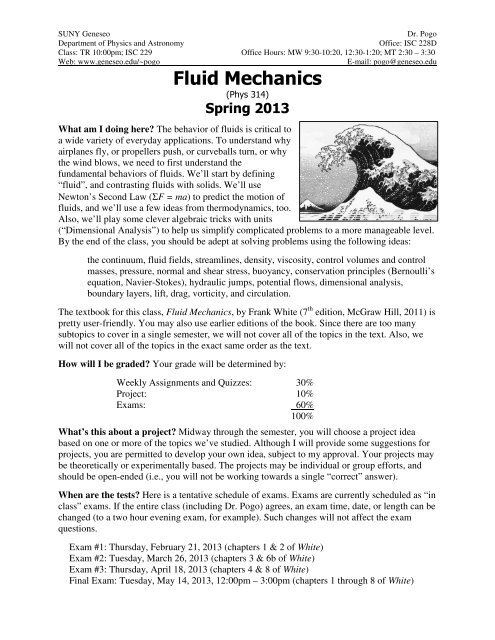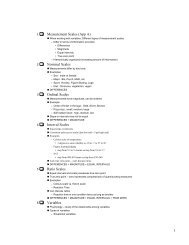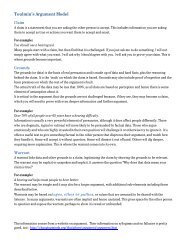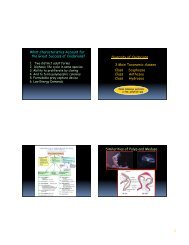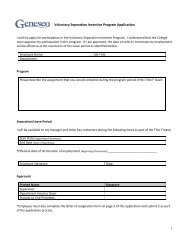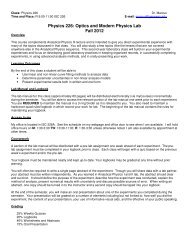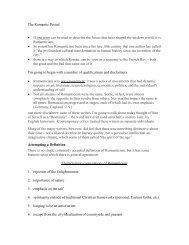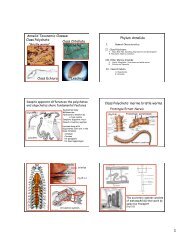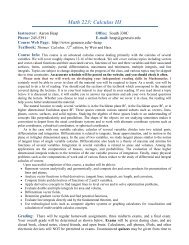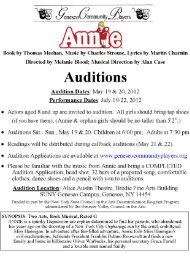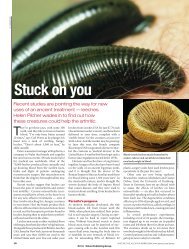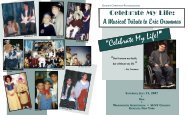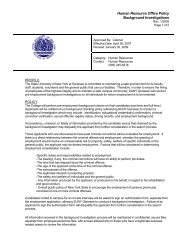Fluid Mechanics - SUNY Geneseo
Fluid Mechanics - SUNY Geneseo
Fluid Mechanics - SUNY Geneseo
You also want an ePaper? Increase the reach of your titles
YUMPU automatically turns print PDFs into web optimized ePapers that Google loves.
<strong>SUNY</strong> <strong>Geneseo</strong><br />
Department of Physics and Astronomy<br />
Dr. Pogo<br />
Office: ISC 228D<br />
Class: TR 10:00pm; ISC 229 Office Hours: MW 9:30-10:20, 12:30-1:20; MT 2:30 – 3:30<br />
Web: www.geneseo.edu/~pogo<br />
E-mail: pogo@geneseo.edu<br />
<strong>Fluid</strong> <strong>Mechanics</strong><br />
(Phys 314)<br />
Spring 2013<br />
What am I doing here? The behavior of fluids is critical to<br />
a wide variety of everyday applications. To understand why<br />
airplanes fly, or propellers push, or curveballs turn, or why<br />
the wind blows, we need to first understand the<br />
fundamental behaviors of fluids. We’ll start by defining<br />
“fluid”, and contrasting fluids with solids. We’ll use<br />
Newton’s Second Law (ΣF = ma) to predict the motion of<br />
fluids, and we’ll use a few ideas from thermodynamics, too.<br />
Also, we’ll play some clever algebraic tricks with units<br />
(“Dimensional Analysis”) to help us simplify complicated problems to a more manageable level.<br />
By the end of the class, you should be adept at solving problems using the following ideas:<br />
the continuum, fluid fields, streamlines, density, viscosity, control volumes and control<br />
masses, pressure, normal and shear stress, buoyancy, conservation principles (Bernoulli’s<br />
equation, Navier-Stokes), hydraulic jumps, potential flows, dimensional analysis,<br />
boundary layers, lift, drag, vorticity, and circulation.<br />
The textbook for this class, <strong>Fluid</strong> <strong>Mechanics</strong>, by Frank White (7 th edition, McGraw Hill, 2011) is<br />
pretty user-friendly. You may also use earlier editions of the book. Since there are too many<br />
subtopics to cover in a single semester, we will not cover all of the topics in the text. Also, we<br />
will not cover all of the topics in the exact same order as the text.<br />
How will I be graded? Your grade will be determined by:<br />
Weekly Assignments and Quizzes: 30%<br />
Project: 10%<br />
Exams: 60%<br />
100%<br />
What’s this about a project? Midway through the semester, you will choose a project idea<br />
based on one or more of the topics we’ve studied. Although I will provide some suggestions for<br />
projects, you are permitted to develop your own idea, subject to my approval. Your projects may<br />
be theoretically or experimentally based. The projects may be individual or group efforts, and<br />
should be open-ended (i.e., you will not be working towards a single “correct” answer).<br />
When are the tests? Here is a tentative schedule of exams. Exams are currently scheduled as “in<br />
class” exams. If the entire class (including Dr. Pogo) agrees, an exam time, date, or length can be<br />
changed (to a two hour evening exam, for example). Such changes will not affect the exam<br />
questions.<br />
Exam #1: Thursday, February 21, 2013 (chapters 1 & 2 of White)<br />
Exam #2: Tuesday, March 26, 2013 (chapters 3 & 6b of White)<br />
Exam #3: Thursday, April 18, 2013 (chapters 4 & 8 of White)<br />
Final Exam: Tuesday, May 14, 2013, 12:00pm – 3:00pm (chapters 1 through 8 of White)
<strong>SUNY</strong> <strong>Geneseo</strong><br />
Department of Physics and Astronomy<br />
Dr. Pogo<br />
Office: ISC 228D<br />
Class: TR 10:00pm; ISC 229 Office Hours: MW 9:30-10:20, 12:30-1:20; MT 2:30 – 3:30<br />
Web: www.geneseo.edu/~pogo<br />
E-mail: pogo@geneseo.edu<br />
Written Homework Rules<br />
The entire point of having written assignments is to help you improve your professionalism.<br />
Therefore, unlike the CAPA portion of each weekly assignment, your grade will be based on<br />
factors other than whether you get the right answer.<br />
1) Use exactly 8½ × 11 inch paper. I will measure it with a ruler. Do not use spiral ring paper.<br />
2) Use only one side of each sheet<br />
3) Put your name on the top of every sheet. Put the assignment number on the top of the first<br />
page (e.g., “<strong>Fluid</strong>s, Written Assignment #3).<br />
4) Staple all your sheets together. Paper-clips and torn corners are not permitted.<br />
5) Clearly and systematically indicate what is given, and what is sought.<br />
6) Work must progress linearly down the page. If your solution initially meanders around the<br />
page, I expect you to recopy your solutions.<br />
7) Use a pencil. Erase errors instead of blotching them out.<br />
8) Draw and use Free Body diagrams as appropriate for all problems. Define and use<br />
coordinate systems. Specify your choice of “free body”. Label your forces.<br />
9) Define your symbols, and use subscripts. Not all velocities can be called “V”, not all<br />
pressures can be called “p”. Every symbol must be unique and clearly defined. Make a list<br />
or table of relevant symbols and their values when this will help me to understand your<br />
solution.<br />
10) Do not even bother to submit nonsensical results (e.g., a negative pressure).<br />
11) Use words and/or pictures to clarify your method of solution and your symbol definitions.<br />
12) Solutions should be symbolic. Include the initial fundamental formulas, but don’t show<br />
every step of intermediate algebra. If, for some reason, your solution uses numeric values,<br />
show no more than 4 significant figures, and include units. The symbol “:=” is (now and for<br />
the rest of your professional life), unacceptable for written work, along with other<br />
“computational” notation (“^”, “E”, “*”, etc.).<br />
13) Box your answers.<br />
14) Plots should be professional and no smaller than 3 × 5 inches. Do not use default font sizes,<br />
default trendline formatting (where every variable is apparently an x or a y), default line<br />
widths, etc.<br />
What if I have trouble with the homework? Come see me during office hours (see times listed<br />
above) and I’ll try to point you in the right direction. You may never visit office hours for help<br />
on the same day that an assignment is due (you should have gotten help much earlier than that,<br />
and I won’t encourage irresponsible procrastination). Also, I know that most of you will work in<br />
groups, and I won’t attempt to stop it. However, the learning is in the doing. Nobody on this planet learns<br />
from copying somebody else’s work, no matter how clear or correct it is. Every part of every problem that<br />
you let somebody else do for you is something that you are deciding that you just don’t want to learn.<br />
You will not have their help on exams!
<strong>SUNY</strong> <strong>Geneseo</strong><br />
Dr. Pogo<br />
Department of Physics and Astronomy<br />
Office: ISC 228D<br />
Class: TR 10:00pm; ISC 229 Office Hours: MW 9:30-10:20, 12:30-1:20; MT 2:30 – 3:30<br />
Web: www.geneseo.edu/~pogo<br />
E-mail: pogo@geneseo.edu<br />
Learning Outcomes:<br />
At the end of this course, students will be adept at solving physical problems involving fluids<br />
(e.g., air, water, and oil) using the following techniques:<br />
• Streamlines and streamfunctions<br />
• Control volumes<br />
• Control masses<br />
• Buoyancy and Archimedes’ principle<br />
• Conservation of mass and the continuity equation<br />
• Conservation of momentum, including both Bernoulli’s equation and the Navier-Stokes<br />
equations.<br />
• Potential flow analysis<br />
• Dimensional analysis and similitude<br />
In addition, students will be knowledgeable about the following fluids properties and<br />
descriptions:<br />
• The continuum model for describing fluids<br />
• Pressure, normal stress, and shear stress<br />
• Density, viscosity, vorticity, and circulation<br />
• Lift and drag<br />
• Boundary layers<br />
• Hydraulic jumps and fluid instability


